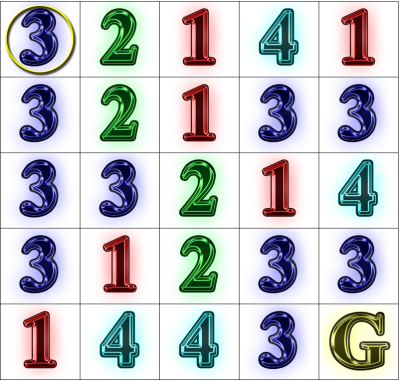
Rook Jumping Maze Instructions: Starting at the circled cell in the upper-left corner, find a path to the goal cell marked “G”. From each numbered cell, one may move that exact number of cells horizontally or vertically in a straight line. How many moves does the shortest path have?

Solution (select to reveal): [19 moves: RDLRUDRLRLUDLDRRUDD]
Problem: Using a form of stochastic local search called Simulated Annealing, search the space of 5-by-5 Rook Jumping Mazes (RJMs) for a given number of iterations and print the best maze evaluated according to the objective function specified by Rook Jumping Maze Evaluation.
One problem with Hill Descent with Random Uphill Steps is that all uphill steps are equally likely. A small uphill step would generally be more desirable than a large uphill step. Simulated annealing is a stochastic local search technique based on an analogy to energy distributions in heated materials as they cool (i.e. anneal) and "seek" a lower energy state. For example, blacksmiths long ago observed that quenching, i.e. rapid cooling, would lead to a harder, more brittle metal than annealing, i.e. slow cooling, which yields a more malleable metal with a lower energy and more crystalline configuration.
When the material is heated (high energy input), atoms reconfigure among different possible energies much like a random walk. When the material is rapidly cooled (low/no energy input), atoms reconfigure to lower energy states often getting trapped in local minima. The local minima escape strategy of simulated annealing concerns a temperature schedule, called an annealing schedule, that gradually shifts search from a free random walk to a final descent, while favoring smaller uphill steps over larger ones. In a nutshell, for local minima, there are temperatures where one is more likely to escape than reenter. For more on simulated annealing, see the recommended background readings below.
The practical application of simulated annealing here involves very few modifications to Hill Descent with Random Uphill Steps. Using the definitions of hill descent, we may describe our modified algorithm as follows:
Thus, simulated annealing in this form takes three parameters: number of iterations, initial temperature, and temperature decay rate. Note the acceptance probability for uphill steps: exp((e(j) - e(j')) / T). When the temperature is high, this is close to exp(0) and acceptance of any uphill step is very likely. As the temperature drops to zero, this approaches exp(∞) = 0 so any uphill step would be rejected. In between, a larger uphill step leads to lower probability acceptance.
Possible background readings include:
Input Format:
Output Format:
Sample Transcripts (input underlined):
Iterations? 10000 Initial temperature? 100 Decay rate? 1.0 2 4 3 1 2 3 1 3 3 2 4 2 2 2 3 4 3 3 3 1 1 4 3 4 0 Moves from start: 0 4 1 5 6 7 -- -- 6 -- 1 3 -- 4 2 9 -- 2 11 10 8 4 -- 5 11 -11
Iterations? 10000 Initial temperature? 1 Decay rate? .99 1 3 1 3 3 4 3 3 2 4 1 1 2 3 2 2 3 2 2 4 3 1 4 2 0 Moves from start: 0 1 8 9 2 1 12 6 11 2 17 18 19 16 20 4 2 5 10 3 14 13 7 15 21 -21
Iterations? 10000 Initial temperature? 100 Decay rate? .95 3 3 3 4 4 3 3 1 1 2 2 3 2 2 4 3 3 3 1 4 3 1 4 4 0 Moves from start: 0 14 4 1 15 8 11 10 9 10 6 4 7 3 5 1 13 3 2 3 7 12 8 2 16 -16
Questions: